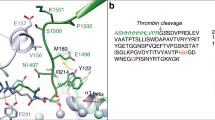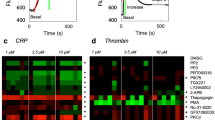Abstract
Integrin αIIbβ3 has emerged as an important therapeutic target for thrombotic vascular diseases owing to its pivotal role in mediating platelet aggregation through interaction with adhesive ligands. In the search for effective anti-thrombotic agents that can be administered orally without inducing the high-affinity ligand binding state, we recently discovered via high-throughput screening of 33,264 compounds a novel, αIIbβ3-selective inhibitor (RUC-1) of adenosine-5′-diphosphate (ADP) -induced platelet aggregation that exhibits a different chemical scaffold and mode of binding with respect to classical Arg-Gly-Asp (RGD)-mimicking αIIbβ3 antagonists. Most importantly, RUC-1 and its higher-affinity derivative, RUC-2, do not induce major conformational changes in the protein β3 subunit or prime the receptor to bind ligand. To identify additional αIIbβ3-selective chemotypes that inhibit platelet aggregation through similar mechanisms, we screened in silico over 2.5 million commercially available, ‘lead-like’ small molecules based on complementarity to the predicted binding mode of RUC-2 into the RUC-1-αIIbβ3 crystal structure. This first reported structure-based virtual screening application to the αIIbβ3 integrin led to the identification of 2 αIIbβ3-selective antagonists out of 4 tested, which compares favorably with the 0.003 % “hit rate” of our previous high-throughput chemical screening study. The newly identified compounds, like RUC-1 and RUC-2, showed specificity for αIIbβ3 compared to αVβ3 and did not prime the receptor to bind ligand. They thus may hold promise as αIIbβ3 antagonist therapeutic scaffolds.








Similar content being viewed by others
References
Lopez AD, Mathers CD, Ezzati M, Jamison DT, Murray CJL (2006) Measuring the global burden of disease and risk factors, 1990–2001. Global burden of disease and risk factors, 2011/01/21 edn. World Bank, Washington
Roger VL, Go AS, Lloyd-Jones DM, Adams RJ, Berry JD, Brown TM, Carnethon MR, Dai S, de Simone G, Ford ES, Fox CS, Fullerton HJ, Gillespie C, Greenlund KJ, Hailpern SM, Heit JA, Ho PM, Howard VJ, Kissela BM, Kittner SJ, Lackland DT, Lichtman JH, Lisabeth LD, Makuc DM, Marcus GM, Marelli A, Matchar DB, McDermott MM, Meigs JB, Moy CS, Mozaffarian D, Mussolino ME, Nichol G, Paynter NP, Rosamond WD, Sorlie PD, Stafford RS, Turan TN, Turner MB, Wong ND, Wylie-Rosett J (2011) Heart disease and stroke statistics—2011 update: a report from the American Heart Association. Circulation 123(4):e18–e209
Yang G, Kong L, Zhao W, Wan X, Zhai Y, Chen LC, Koplan JP (2008) Emergence of chronic non-communicable diseases in China. Lancet 372(9650):1697–1705
Hynes RO (2002) Integrins: bidirectional, allosteric signaling machines. Cell 110(6):673–687
Springer TA, Zhu J, Xiao T (2008) Structural basis for distinctive recognition of fibrinogen gammaC peptide by the platelet integrin alphaIIbbeta3. J Cell Biol 182(4):791–800
Basani RB, D’Andrea G, Mitra N, Vilaire G, Richberg M, Kowalska MA, Bennett JS, Poncz M (2001) RGD-containing peptides inhibit fibrinogen binding to platelet alpha(IIb)beta3 by inducing an allosteric change in the amino-terminal portion of alpha(IIb). J Biol Chem 276(17):13975–13981
Hagemeyer CE, Peter K (2010) Targeting the platelet integrin GPIIb/IIIa. Curr Pharm Des 16(37):4119–4133
Cox D (2004) Oral GPIIb/IIIa antagonists: what went wrong? Curr Pharm Des 10(14):1587–1596
Chew DP, Bhatt DL, Topol EJ (2001) Oral glycoprotein IIb/IIIa inhibitors: why don’t they work? Am J Cardiovasc Drugs 1(6):421–428
Scirica BM, Cannon CP, Cooper R, Aster RH, Brassard J, McCabe CH, Charlesworth A, Skene AM, Braunwald E (2006) Drug-induced thrombocytopenia and thrombosis: evidence from patients receiving an oral glycoprotein IIb/IIIa inhibitor in the Orbofiban in patients with unstable coronary syndromes-(OPUS-TIMI 16) trial. J Thromb Thrombolysis 22(2):95–102
Blue R, Murcia M, Karan C, Jirouskova M, Coller BS (2008) Application of high-throughput screening to identify a novel alphaIIb-specific small-molecule inhibitor of alphaIIbbeta3-mediated platelet interaction with fibrinogen. Blood 111(3):1248–1256
Zhu J, Negri A, Provasi D, Filizola M, Coller BS, Springer TA (2010) Closed headpiece of integrin alphaIIbbeta3 and its complex with an alphaIIbbeta3-specific antagonist that does not induce opening. Blood 116(23):5050–5059
McCoy J, Shen M, Huang W, Coller B, Thomas CJ (2010) Inhibitors of platelet integrin alphallbbeta3. Probe reports from the NIH molecular libraries program [Internet] Bethesda (MD): National Center for Biotechnology Information (US); 2010 Mar 27 [updated 2011 Mar 3]
Zhu J, Choi WS, McCoy JG, Negri A, Naini S, Li J, Shen M, Huang W, Bougie D, Rasmussen M, Aster R, Thomas CJ, Filizola M, Springer TA, Coller BS (2012) Structure-guided design of a high-affinity platelet integrin alphaIIbbeta3 receptor antagonist that disrupts Mg(2)(+) binding to the MIDAS. Sci Trans Med 4(125):125ra132
Irwin JJ, Shoichet BK (2005) ZINC-a free database of commercially available compounds for virtual screening. J Chem Inf Model 45:177–182
Boström J, Greenwood JR, Gottfries J (2003) Assessing the performance of OMEGA with respect to retrieving bioactive conformations. J Mol Graph Model 21(5):449–462
Weiner SJ, Kollman PA, Nguyen DT, Case DA (1986) An all atom force field for simulations of proteins and nucleic acids. J Comp Chem 7(2):230–252
Chambers CC, Hawkins GD, Cramer CJ, Truhlar DG (1996) Model for aqueous solvation based on class IV atomic charges and first solvation shell effects. J Phys Chem 100:16385–16398
Li JB, Zhu TH, Cramer CJ, Truhlar DG (1998) New class IV charge model for extracting accurate partial charges from wave functions. J Phys Chem A 102:1820–1831
Lorber DM, Shoichet BK (1998) Flexible ligand docking using conformational ensembles. Protein Sci 7(4):938–950
Lorber DM, Shoichet BK (2005) Hierarchical docking of databases of multiple ligand conformations. Curr Top Med Chem 5(8):739–749
Kuntz ID, Blaney JM, Oatley SJ, Langridge R, Ferrin TE (1982) A geometric approach to macromolecule-ligand interactions. J Mol Biol 161(2):269–288
Nicholls A, Honig B (1991) A rapid finite difference algorithm, utilizing successive over-relaxation to solve the Poisson–Boltzmann equation. J Comp Chem 12(4):435–445
Weiner SJ, Kollman PA, Case DA, Singh UC, Ghio C, Alagona G, Profeta S, Weiner PA (1984) A new force-field for molecular mechanical simulation of nucleic-acids and proteins. J Am Chem Soc 106:765–784
Shoichet BK, Leach AR, Kuntz ID (1999) Ligand solvation in molecular docking. Proteins Struct Funct Genet 34:4–16
Wei BQQ, Baase WA, Weaver LH, Matthews BW, Shoichet BK (2002) A model binding site for testing scoring functions in molecular docking. J Mol Biol 322:339–355
Hinselmann G, Rosenbaum L, Jahn A, Fechner N, Zell A (2011) jCompoundMapper: an open source Java library and command-line tool for chemical fingerprints. J Cheminform 3(3):1–14
Gasteiger J, Rudolph C, Sadowski J (1990) Automatic generation of 3D Atomic coordinates for organic molecules. Tetrahedron Comp Method 3:537–547
Du XP, Plow EF, Frelinger AL III, O’Toole TE, Loftus JC, Ginsberg MH (1991) Ligands “activate” integrin alpha IIb beta 3 (platelet GPIIb-IIIa). Cell 65(3):409–416
Zhou Y, Peng H, Ji Q, Qi J, Zhu Z, Yang C (2006) Discovery of small molecule inhibitors of integrin alphavbeta3 through structure-based virtual screening. Bioorg Med Chem Lett 16(22):5878–5882
Willett P, Barnard JM, Downs GM (1998) Chemical similarity searching. J Chem Inf Comput Sci 38(6):983–996
Rogers D, Brown RD, Hahn M (2005) Using extended-connectivity fingerprints with Laplacian-modified Bayesian analysis in high-throughput screening follow-up. J Biomol Screen 10(7):682–686
Wawer M, Bajorath J (2010) Similarity-potency trees: a method to search for SAR information in compound data sets and derive SAR rules. J Chem Inf Model 50(8):1395–1409
Hays SJ, Caprathe BW, Gilmore JL, Amin N, Emmerling MR, Michael W, Nadimpalli R, Nath R, Raser KJ, Stafford D, Watson D, Wang K, Jaen JC (1998) 2-amino-4H-3,1-benzoxazin-4-ones as inhibitors of C1r serine protease. J Med Chem 41(7):1060–1067
Plummer JS, Cai C, Hays SJ, Gilmore JL, Emmerling MR, Michael W, Narasimhan LS, Watson MD, Wang K, Nath R, Evans LM, Jaen JC (1999) Benzenesulfonamide derivatives of 2-substituted 4H–3,1-benzoxazin-4-ones and benzthiazin-4-ones as inhibitors of complement C1r protease. Bioorg Med Chem Lett 9(6):815–820
Chang JH, Lee IS, Kim HK, Cho YK, Park JM, Kim SW, Choi MG, Chung IS (2009) Nafamostat for prophylaxis against post-endoscopic retrograde cholangiopancreatography pancreatitis compared with gabexate. Gut Liver 3(3):205–210
Fuse I, Higuchi W, Toba K, Aizawa Y (1999) Inhibitory mechanism of human platelet aggregation by nafamostat mesilate. Platelets 10(4):212–218
Hodohara K, Fujiyama Y, Hosoda S, Yasunaga K (1989) Inhibition of fibrinogen binding to ADP-stimulated human platelets by synthetic serine protease inhibitors. Blood Vessel 20:213–219
Ono S, Inoue Y, Yoshida T, Ashimori A, Kosaka K, Imada T, Fukaya C, Nakamura N (1999) Preparation and pharmacological evaluation of novel glycoprotein (Gp) IIb/IIIa antagonists. 1. The selection of naphthalene derivatives. Chem Pharm Bull (Tokyo) 47(12):1685–1693
Bovy PR, Rico JG, Rogers TE, Tjoeng FS, Zablocki JA (1993) Substituted β-amino acid derivatives useful as platelet aggregation inhibitors and intermediates thereof. Patent number: 5239113, Issue date: 24 Aug 1993
Acknowledgments
The authors wish to thank Drs. Mihaly Mezei and Davide Provasi from Mount Sinai School of Medicine for technical assistance with similarity calculations, Joseph Fernandez and Nagarajan Chandramouli from the Rockefeller University Proteomics Resource Center for mass spectroscopy analysis and compound purification, Yufeng Wei from the Rockefeller University Spectroscopy Resource Center for NMR analysis, and Mayte Suarez-Farinas for statistical analysis. This work was supported by NHLBI grant HL019278, a Clinical and Translational Science Award 2UL1RR024143 to Rockefeller University, and funds from Stony Brook University. Computations were run on resources available through the Scientific Computing Facility of Mount Sinai School of Medicine.
Author information
Authors and Affiliations
Corresponding author
Electronic supplementary material
Below is the link to the electronic supplementary material.
Rights and permissions
About this article
Cite this article
Negri, A., Li, J., Naini, S. et al. Structure-based virtual screening of small-molecule antagonists of platelet integrin αIIbβ3 that do not prime the receptor to bind ligand. J Comput Aided Mol Des 26, 1005–1015 (2012). https://doi.org/10.1007/s10822-012-9594-6
Received:
Accepted:
Published:
Issue Date:
DOI: https://doi.org/10.1007/s10822-012-9594-6




